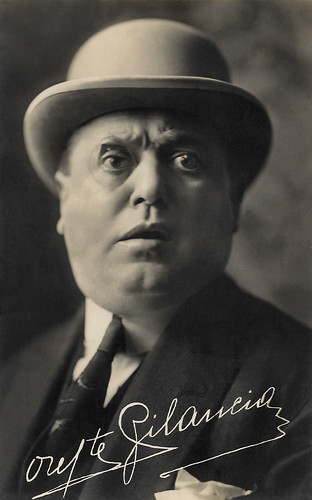
Italian postcard by Ed. Ballerini & Fratini, Firenze.

Italian postcard by Ed. Ballerini & Fratini, Firenze. Photo: Scoffone.
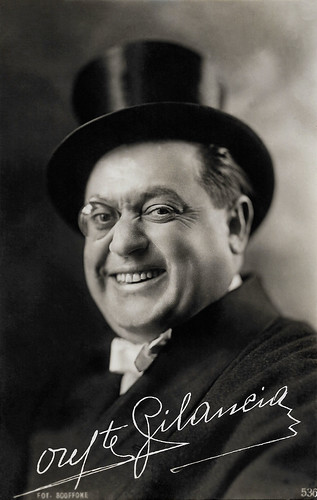
Italian postcard by Ed. Ballerini & Fratini, Firenze, no. 536. Photo: Scoffone.

Italian postcard by Ed. Ballerini & Fratini, Firenze, no. 537. Photo: Scoffone.
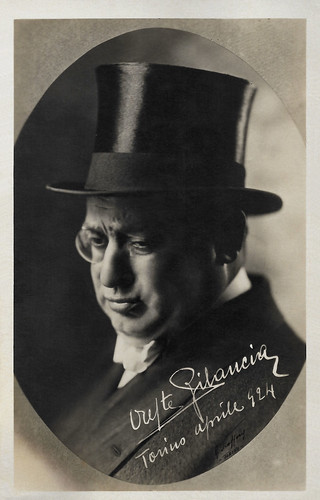
Italian postcard by Vettori, Bologna. Photo: Scoffone, Turin. Caption: Turin, April 1924.
Rotund bonvivant
Oreste Bilancia was born in Catania, Sicily in 1881. His acting career began in 1902 at the theatre company Galli-Gusti-Ciarli-Bracci, where he acted as a comedian. Next, he played at the Calabresi-Severi company.
From 1910-1913, he was the manager of the casino of Sanremo, and then from 1914 on, he was the manager of the Kursaal of Montecatini. In late 1914, the Turin-based film production company Ambrosio engaged him as a film actor. The rotund Bilancia, often wearing a monocle, represented the bonvivant and gentleman in many Italian silent films.
He was the co-star of Fernanda Negri Pouget and Helena Makowska in Lucciola/Firefly (Augusto Genina, 1917), Febo Mari and Helena Makowska in Il fauno/The Faun (Febo Mari, 1917), Italia Almirante Manzini in Femmina/Female (Augusto Genina, 1918), Hedda Gabler (Gero Zambuto, Giovanni Pastrone, 1920), and La statua di carne/The Statue of Flesh (Mario Almirante, 1921).
In the early 1920s, he was part of the regular cast of the Fert company, which included not only the Italia Almirante films but also some Maciste- and Saetta-films.
For the Alba company, Fert-actors like Bilancia and Alberto Collo played in films such as Il controllore dei vagoni letto/The Controller of the sleeping wagon (Mario Almirante, 1922) and Il fornaretto di Venezia/The Scapegoat of Venice (Mario Almirante, 1923) starring Alberto Collo and
Amleto Novelli.
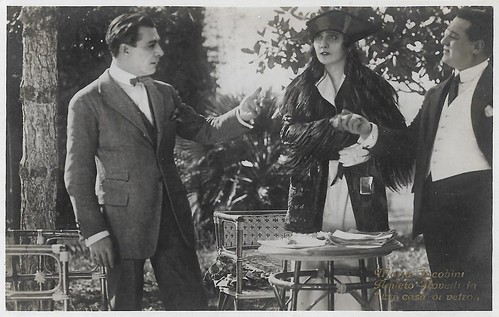
Italian postcard by G.B. Falci, Milano. Photo: Fert. Maria Jacobini, Amleto Novelli and Oreste Bilancia in La casa di vetro/The Glass House (Gennaro Righelli, 1920).
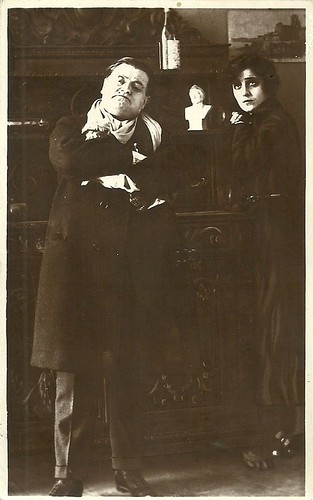
Italian postcard. Photo: Fert. Maria Jacobini and Oreste Blancia in La casa di vetro/The glass house (Gennaro Righelli, 1920).
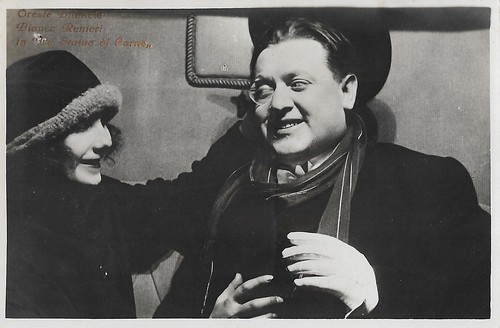
Italian postcard by G.B. Falci, Milano. Photo: La Fotominio. Oreste Bilancia and Bianca Renieri in La statua di carne/The statue of flesh (Mario Almirante, 1921). Caption: Paolo's friend reveals to Maria's friend he is not a poor bum but a wealthy aristocrat.
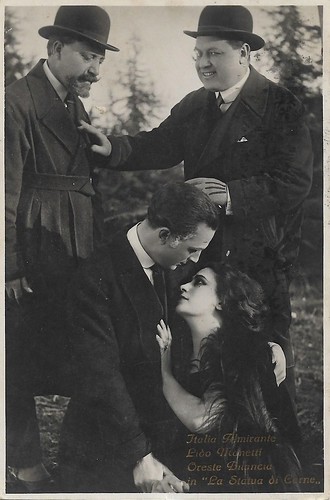
Italian postcard by G.B. Falci, Milano. Photo: Italia Almirante Manzini, Lido Manetti and Oreste Bilancia in the closing scene of La statua di carne/The Statue of flesh (1921).

Italian postcard by G.B. Falci, Milano. Photo: Italia Almirante Manzini and Oreste Bilancia in La chiromante/The Fortune Teller (Mario Almirante, 1921).
Strong men
When the Italian film industry imploded, Oreste Bilancia accepted an offer to work in Germany in 1925. Until the end of the silent era, he performed in many German films there, such as films with the Italian ‘Forzuti’ (strongmen) like Carlo Aldini, Domenico Gambino/Saetta, and Luciano Albertini.
He also worked with other emigrated Italian stars such as Maria Jacobini and Livio Pavanelli. With Jacobini, Bilancia co-starred in the German-Italian coproduction Der Bastard/The Bastard (Gennaro Righelli, 1925). In Italy, Bilancia played with the French actor Marcel Lévesque and Pavanelli in Florette e Patapon/Florette and Patapon (Amleto Palermi, 1928).
When sound cinema set in, Bilancia definitively returned to Italy where he did something peculiar. Between 1929 and 1931, early American sound films like Morocco (Josef von Sternberg, 1930) with Marlene Dietrich, were presented in Italy with inserted scenes in which Bilancia and other Italian actors narrated what just had been said in the original films.
At the Paramount sound studios in Paris, he also played in Italian versions of American films, directed by Jack Salvatori. In the 1930s and early 1940s, Bilancia acted in many Italian comedies (a.o. with Macario and Totò), opera films, historical films, and modern melodramas. In 1942 he was also visible – although now without his corpulence of former days – as a pharmacist in the realist tragicomedy Quattro passi fra le nuvole/A Walk in the Clouds (Alessandro Blasetti, 1942), starring Gino Cervi.
Oreste Bilancia acted in almost 150 films, of which many at the Fert company in Turin. Parallel to his film career, Bilancia had also a rich stage career and he performed with such actors as Anna Magnani. Bilancia died in Rome in 1945, a few months after the Liberation. He was 64. Bilancia was married to actress Asta Gundt.
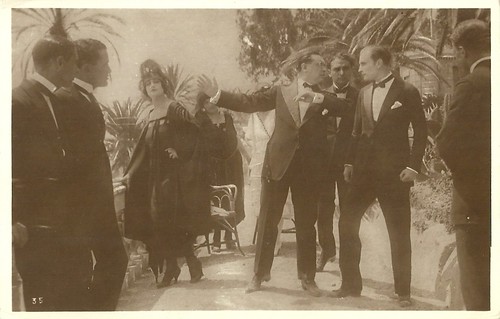
Italian postcard, no. 35. Photo: Fert. Italia Almirante Manzini, Oreste Bilancia, and Lido Manetti in La chiromante/The Fortune Teller aka La maschera del male (Mario Almirante, 1922). Caption: You fool, if you stay with her, you'll be worthy of her!

Italian postcard by Ed. Ballerini & Fratini, Firenze, no. 212. Photo: Alba Film. Annibale Betrone (right) as The Jester, Oreste Bilancia as Floridoro, and Alberto Collo as Giano in L'arzigogolo/The Court Jester (Mario Almirante, 1924), based on a play by Sem Benelli. Caption: The Jester: Oh my pumpkin!... I could switch your head with that of a cow.
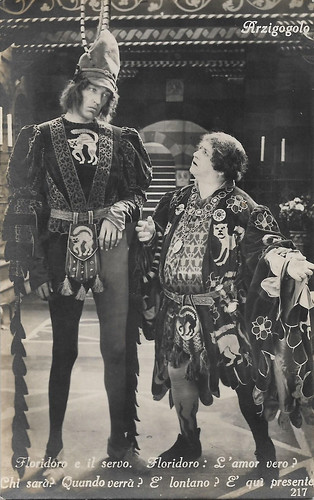
Italian postcard by Ed. Ballerini & Fratini, Firenze, no. 217. Photo: Alba Film. Oreste Bilancia as Floridoro in L'arzigogolo/The Court Jester (Mario Almirante, 1924), based on a play by Sem Benelli. Caption: Floridoro and the servant. Floridoro: Her true love? Who is it? When will he come? Is he far away? Is he here?
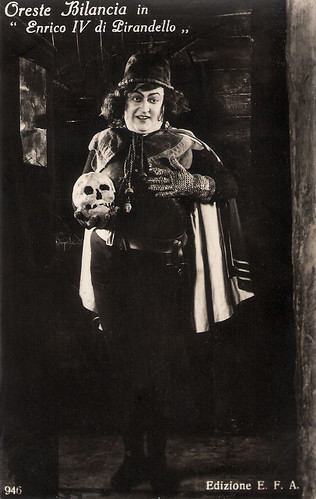
Italian postcard by Edizione A. Traldi, Milano, no. 946. Oreste Bilancia in Die Flucht in die Nacht/The Flight in the Night (Amleto Palermi, 1926), based on the play 'Enrico IV' by Luigi Pirandello.
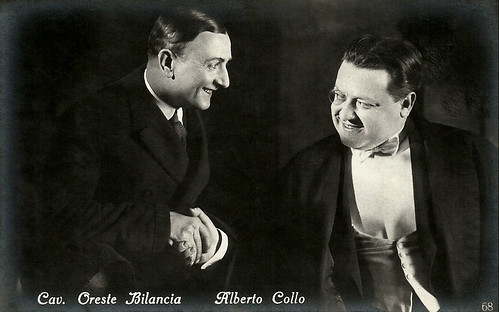
Italian postcard by Ed. Traldi, Milano, no. 68. With Alberto Collo.
Sources: Wikipedia (Italian, German and English), and IMDb.
This post was last updated on 24 May 2023.
1 comment:
Un post para Orchidea de Santis, please
Post a Comment